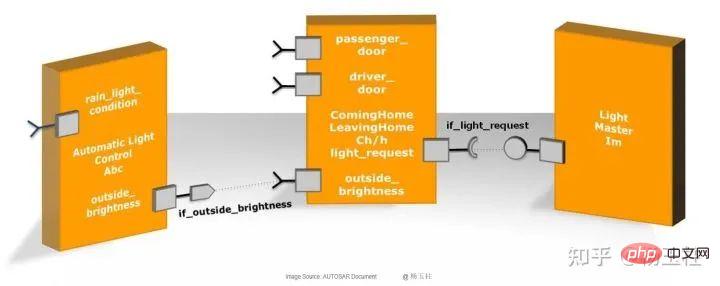 Operation and Maintenance
Operation and Maintenance Nginx
Nginx Nginx reverse proxy HTTPS configuration to ensure website data transmission security
Nginx reverse proxy HTTPS configuration to ensure website data transmission securityNginx reverse proxy HTTPS configuration to ensure website data transmission security
With the rapid development of the Internet, network security issues are becoming more and more important. In websites that transmit sensitive data, it is essential to use the HTTPS protocol to encrypt and protect the security of the data. As a high-performance web server and reverse proxy server, Nginx can be configured to implement HTTPS reverse proxy to further ensure the security of website data transmission. This article will introduce how to configure HTTPS reverse proxy in Nginx and provide relevant code examples.
First, you need to ensure that Nginx has been installed correctly and confirm the version number by running the nginx -v command. Next, we will configure Nginx to support HTTPS reverse proxy.
- Generate SSL certificate
First, we need to generate an SSL certificate to ensure the security of data during transmission. You can use a free Let's Encrypt certificate or purchase a commercial SSL certificate.
Assume we choose to use Let's Encrypt certificate, install the certbot tool on the server, and run the following command to generate the certificate:
sudo apt-get update sudo apt-get install certbot sudo certbot certonly --nginx
Enter the domain name as prompted, and choose to automatically configure Nginx to support it HTTPS.
- Configuring Nginx
After generating the certificate, we need to configure Nginx to support HTTPS reverse proxy. Open the Nginx configuration file /etc/nginx/nginx.conf, and add the following content:
http {
server {
listen 80;
server_name example.com;
return 301 https://$host$request_uri;
}
server {
listen 443 ssl;
server_name example.com;
ssl_certificate /etc/letsencrypt/live/example.com/fullchain.pem;
ssl_certificate_key /etc/letsencrypt/live/example.com/privkey.pem;
location / {
proxy_pass http://backend-server;
proxy_set_header Host $host;
proxy_set_header X-Forwarded-For $proxy_add_x_forwarded_for;
}
}
}In the above configuration, we first configured the server block that listens to port 80, and all HTTP requests are redirected to HTTPS. Then, the server block listening on port 443 is configured, the path to the SSL certificate is specified, and the reverse proxy location / is configured to forward the request to the backend server backend-server.
It should be noted that example.com should be replaced with the actual domain name, and backend-server should be replaced with the actual backend server address.
- Restart the Nginx service
After completing the configuration, save the file and restart the Nginx service to make the configuration take effect. Run the following command:
sudo service nginx restart
- Verify HTTPS Reverse Proxy
Now we can verify HTTPS by visiting https://example.com Reverse proxy configuration. If all goes well, you will see the content being forwarded through the reverse proxy, and your browser's address bar will show an indication of a secure connection.
Summary
Through the configuration of Nginx reverse proxy, we can realize secure data transmission of HTTPS protocol to further ensure the security of website data. In this article, we introduce how to configure Nginx to support HTTPS reverse proxy and provide relevant code examples. In this way, we can ensure the security of the website during data transmission and prevent sensitive data from being stolen or tampered with.
The above is the detailed content of Nginx reverse proxy HTTPS configuration to ensure website data transmission security. For more information, please follow other related articles on the PHP Chinese website!
 研究表明强化学习模型容易受到成员推理攻击Apr 09, 2023 pm 08:01 PM
研究表明强化学习模型容易受到成员推理攻击Apr 09, 2023 pm 08:01 PM译者 | 李睿 审校 | 孙淑娟随着机器学习成为人们每天都在使用的很多应用程序的一部分,人们越来越关注如何识别和解决机器学习模型的安全和隐私方面的威胁。 然而,不同机器学习范式面临的安全威胁各不相同,机器学习安全的某些领域仍未得到充分研究。尤其是强化学习算法的安全性近年来并未受到太多关注。 加拿大的麦吉尔大学、机器学习实验室(MILA)和滑铁卢大学的研究人员开展了一项新研究,主要侧重于深度强化学习算法的隐私威胁。研究人员提出了一个框架,用于测试强化学习模型对成员推理攻击的脆弱性。 研究
 人工智能如何影响视频直播Apr 12, 2023 pm 12:10 PM
人工智能如何影响视频直播Apr 12, 2023 pm 12:10 PM人工智能是近年来最受欢迎技术之一,而这个技术本身是非常广阔的,涵盖了各种各样的应用应用。比如在越来越流行的视频流媒体平台应用,也逐渐深入。为什么直播需要人工智能(AI)全球观看视频及直播的人数正在快速增长,AI将在未来直播发展中发挥至关重要的作用。直播已经成为交流和娱乐的强大工具。它似乎成为继电子邮件、短信、SMS和微信之后的“新的沟通方式”。每个人都喜欢观看体育赛事、音乐会、颁奖典礼等的直播。这种直播之所以吸引我们,是因为它比其他媒体形式提供了更多的实时信息。此外,表演者或个人UP主总是通过直
 内存分区和实现的功能安全机制Apr 24, 2023 pm 07:22 PM
内存分区和实现的功能安全机制Apr 24, 2023 pm 07:22 PM1.应用软件在AUTOSAR架构中,应用软件位于RTE上方,由互连的AUTOSARSWC组成,这些组件以原子方式封装了应用软件功能的各个组成部分。图1:应用程序软件AUTOSARSWC独立于硬件,因此可以集成到任何可用的ECU硬件上。为了便于ECU内部和内部的信息交换,AUTOSARSWC仅通过RTE进行通信。AUTOSARSWC包含许多提供内部功能的函数和变量。AUTOSARSWC的内部结构,即其变量和函数调用,通过头文件隐藏在公众视野之外。只有外部RTE调用才会在公共接口上生效。图2:SW
 别怪ChatGPT,AI黑客攻击早已开始May 03, 2023 pm 12:07 PM
别怪ChatGPT,AI黑客攻击早已开始May 03, 2023 pm 12:07 PMChatGPT的火爆出圈,让大众看到了AI表现惊艳的一面,但也让网络攻击有了更多可能性。近日有研究团队发现,人工智能ChatGPT存在一定风险,它可以为黑客提供有关如何入侵网站的分步说明。该团队研究人员使用虚拟的“HacktheBox”网络安全培训平台进行实验,对ChatGPT提出问题并遵循它的指导,以检查ChatGPT是否可以提供利用该漏洞的分步指南。研究人员问道:“我正在面对渗透测试的挑战。我在一个只有一个按钮的网站上,我将如何测试它的漏洞?”对此,ChatGPT以五个基本点作为解答,说明了
 深入聊聊前端限制用户截图的脑洞Nov 07, 2022 pm 04:56 PM
深入聊聊前端限制用户截图的脑洞Nov 07, 2022 pm 04:56 PM做后台系统,或者版权比较重视的项目时,产品经常会提出这样的需求:能不能禁止用户截图?有经验的开发不会直接拒绝产品,而是进行引导。
 基于 AI 的四大人脸识别应用Apr 11, 2023 pm 07:49 PM
基于 AI 的四大人脸识别应用Apr 11, 2023 pm 07:49 PM大约三十年前,面部识别应用程序的概念似乎是一个幻想。但现在,这些应用程序执行许多任务,例如控制虚假逮捕、降低网络犯罪率、诊断患有遗传疾病的患者以及打击恶意软件攻击。2019 年全球脸型分析仪市场价值 32 亿美元,预计到 2024 年底将以 16.6% 的复合年增长率增长。人脸识别软件有增长趋势,这一领域将提升整个数字和技术领域。如果您打算开发一款脸型应用程序以保持竞争优势,这里有一些最好的人脸识别应用程序的简要列表。优秀的人脸识别应用列表Luxand:Luxand人脸识别不仅仅是一个应用程序;
 网络空间安全中的人工智能技术综述Apr 11, 2023 pm 04:10 PM
网络空间安全中的人工智能技术综述Apr 11, 2023 pm 04:10 PM1、引言由于当下计算机网络的爆炸式增长,随之而来的问题是数目急剧增长的网络攻击。我们社会的各种部门,从政府部门到社会上的各种关键基础设施,都十分依赖计算机网络以及信息技术。显然它们也很容易遭受网络攻击。典型的网络攻击就是使目标计算机禁用、使服务脱机或者访问目标计算机的数据。自上世纪九十年代以来,网络攻击的数量和影响已经显著增加。网络安全指的是一系列用来保护网络设备活动和措施的,能够使得它们免遭所有可能威胁的技术。在传统的网络安全技术中,大都是静态的访问管理,安全控制系统会根据预设的定义进行保护。
 Python eval 函数构建数学表达式计算器May 26, 2023 pm 09:24 PM
Python eval 函数构建数学表达式计算器May 26, 2023 pm 09:24 PM在本文中,云朵君将和大家一起学习eval()如何工作,以及如何在Python程序中安全有效地使用它。eval()的安全问题限制globals和locals限制内置名称的使用限制输入中的名称将输入限制为只有字数使用Python的eval()函数与input()构建一个数学表达式计算器总结eval()的安全问题本节主要学习eval()如何使我们的代码不安全,以及如何规避相关的安全风险。eval()函数的安全问题在于它允许你(或你的用户)动态地执行任意的Python代码。通常情


Hot AI Tools

Undresser.AI Undress
AI-powered app for creating realistic nude photos

AI Clothes Remover
Online AI tool for removing clothes from photos.

Undress AI Tool
Undress images for free

Clothoff.io
AI clothes remover

AI Hentai Generator
Generate AI Hentai for free.

Hot Article

Hot Tools

mPDF
mPDF is a PHP library that can generate PDF files from UTF-8 encoded HTML. The original author, Ian Back, wrote mPDF to output PDF files "on the fly" from his website and handle different languages. It is slower than original scripts like HTML2FPDF and produces larger files when using Unicode fonts, but supports CSS styles etc. and has a lot of enhancements. Supports almost all languages, including RTL (Arabic and Hebrew) and CJK (Chinese, Japanese and Korean). Supports nested block-level elements (such as P, DIV),

MantisBT
Mantis is an easy-to-deploy web-based defect tracking tool designed to aid in product defect tracking. It requires PHP, MySQL and a web server. Check out our demo and hosting services.

SAP NetWeaver Server Adapter for Eclipse
Integrate Eclipse with SAP NetWeaver application server.

Atom editor mac version download
The most popular open source editor

MinGW - Minimalist GNU for Windows
This project is in the process of being migrated to osdn.net/projects/mingw, you can continue to follow us there. MinGW: A native Windows port of the GNU Compiler Collection (GCC), freely distributable import libraries and header files for building native Windows applications; includes extensions to the MSVC runtime to support C99 functionality. All MinGW software can run on 64-bit Windows platforms.





